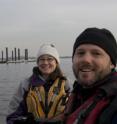Sea level rise and shoreline changes are lead influences on floods from tropical cyclones
Despite the fact that recent studies have focused on climate change impacts on the intensity and frequency of tropical cyclones themselves, a research team led by Jon Woodruff of the University of Massachusetts Amherst found on review of the relevant science that sea level rise and shoreline retreat are the two more certain factors expected to drive an increase in future flood risk from such storms. Writing in the current special issue of Nature dedicated to coastal regions, geoscientist Woodruff, with co-authors Jennifer Irish of Virginia Tech University and Suzana Camargo of Columbia University, say, "Society must learn to live with a rapidly evolving shoreline that is increasingly prone to flooding from tropical cyclones."
Sea level rise and its potential to dramatically change the coastal landscape through shoreline erosion and barrier island degradation, for example, is an under-appreciated and understudied factor that could lead to catastrophic changes in flood risk associated with tropical cyclones, known as hurricanes in the North Atlantic, they say.
Woodruff adds, "There is general agreement that while globally, tropical cyclones will decline in frequency, their strength will be more intense. However, there is less consensus on the magnitude of these changes, and it remains unclear how closely individual regions of tropical cyclone activity will follow global trends."
Despite these uncertainties, the UMass Amherst geoscientist notes, the intensity and frequency of flooding by tropical cyclones will increase significantly due to accelerated sea level rise. Further, the geologic record provides clear examples for the importance of accelerated sea level rise in initiating significant changes in shoreline behavior.
"The era of relatively moderate sea level rise that most coastlines have experienced during the past few millennia is over, and shorelines are now beginning to adjust to a new boundary condition that in most cases serves to accelerate rates of shoreline retreat," he says.
The authors focus on three physical factors they say should be considered together to understand future coastal flooding from hurricanes: Tropical cyclone climatology, relative sea level rise and shoreline change. "Modes of climate variability explain 30 to 45 percent of the variance of tropical cyclone activity within the instrumental historical record. This percentage is far less, however, when considering only storms that make landfall," they point out.
By contrast, "a future rise in sea level is far more certain, particularly along the coastlines most prone to tropical cyclone disruption. For example, a rise in sea level of 1 meter for the New York City region would result in the present-day 100-year flood events occurring every 3 to 20 years. Most engineered coastlines are not designed for this increase in extreme flood frequency, and the dominance of sea-level rise and landscape dynamics on impacts by landfalling tropical cyclones must be acknowledged for effective planning and management of our future coastlines," Woodruff and colleagues write.
They add that "population centers most at risk of tropical cyclone impacts are mainly located along dynamic and subsiding sedimentary coasts that will serve to further enhance the impact of future tropical cyclone floods." People can soften such impacts "partly with adaptive strategies, which include careful stewardship of sediments," and by reducing human-caused land subsidence along many of the world's most populated coastlines due to the extraction of groundwater, oil and gas.
Woodruff and colleagues present prehistoric, instrumental and modeling evidence supporting the dominance of sea level rise on extreme flooding associated with tropical cyclones and the compounding influences of resulting shoreline change on the flood intensity by these events. They say that paleoreconstructions from barrier beach systems and accompanying marshes indicate that "many if these coastal environments have remained remarkably stable over the last few millennia, despite episodic and extreme disruption by tropical cyclones."
In stark contrast, these landforms were either non-existent or quickly washed over by storms, during pre-historic times of rapid sea level rise similar to those projected for the end of this century, in 2100. The authors point out, "It is therefore prudent to expect a decrease in the resilience of these low-lying coastlines from tropical cyclone impacts when enhanced by elevated rates of sea level rise."
Finally, they discuss management strategies in the context of "an almost certain increase in tropical cyclone flood frequency," as well as the need for accurate assessments of the disturbance and resilience of coastal systems to episodic flooding by tropical cyclones under increased rates of sea level rise.
Source: University of Massachusetts at Amherst
Other sources
- Sea level rise and shoreline changes are lead influences on floods from tropical cyclonesfrom Science DailyWed, 4 Dec 2013, 19:30:16 UTC
- Sea level rise and shoreline changes are lead influences on floods from tropical cyclonesfrom PhysorgWed, 4 Dec 2013, 18:00:40 UTC
